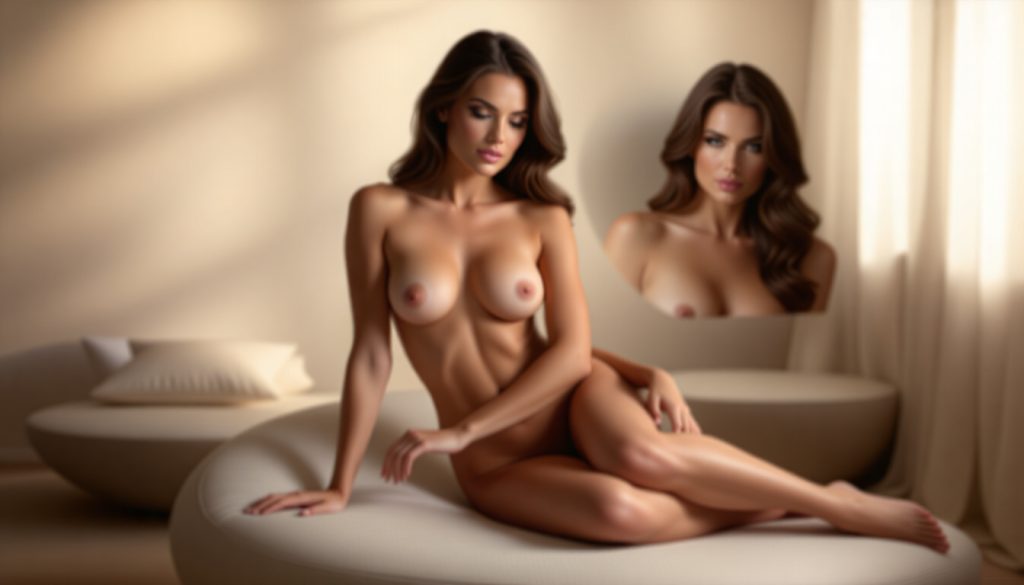What makes someone type “AI-generated lesbian erotica” into a search bar at 1:42 a.m.? Control. Curiosity. Maybe frustration. The truth is, there’s a building wave of queer creators and users reshaping what erotic imagination looks—and feels—like. And it’s not all polished avatars in pixel-perfect threesomes. It’s messy, tender, poetic, explicit, and deeply personal. That’s the sweet spot where queer erotic AI art lives now.
This isn’t passive porn consumption anymore. We’re past the flat, male-gaze-drenched gifs. Today’s queer digital spaces are full of artists, writers, and late-night scrollers turning AI tools into engines for fantasy that actually feels seen. Behind every prompt is someone searching for something they’ve never had full power over: how they’re turned on, how they dream, who they picture when the lights go off.
AI lesbian erotica might sound like a flashy gimmick. But it’s quickly becoming a serious tool for contributors across indie publishing, adult creative work, and queer zine culture. It’s not just porn—it’s autonomy with an undo button. And that freedom reaches far beyond clickbait.
From Fetish Object To Full Creative Control
The shift isn’t subtle—it’s seismic. For years, WLW (women-loving-women) visuals were built for everyone except actual WLW folks. Think: hyper-curated, soulless, softcore girl-on-girl for straight men. Hidden under that was erasure, stereotype, and total lack of nuance.
Now, queer women aren’t consuming content made about them—they’re designing it. With AI’s text-to-image abilities, users input precise prompts that shape visual scenes: body types, facial expressions, emotions, clothes, context. Want a loving moment between two masc women in a makeshift pillow fort? Type it, adjust the lighting, and cue the vibe.
Fantasy is activating, but more so when it respects your identity. It’s one thing to see lesbian love look “hot.” It’s another to see it look real. Driven by personal input and personal need, this creative autonomy is rewriting the script on erotic representation.
AI Platforms Queer Users Are Actually Using
| Platform | Main Features | Free Access | Commercial Use |
|---|---|---|---|
| PromeAI | Scene Remixing, WLW tag filters, body/pose control | Yes (limited) | Yes (paid) |
| OpenArt | Prompt libraries, erotic styles, Discord tips hub | Free credits | Sometimes (depends on model) |
| JoggAI | Erotic animations, kiss simulators, POV loop scenes | Demo access | Check TOS |
| BasedLabs | Artist packs, style-authentic renders | Limited free | Yes (with upgrade) |
Head into any queer NSFW Discord, and you’ll find prompt recipes floating around like forbidden cookbooks. Want “butch vampire holding soft femme’s chin, candlelit castle, 1600s style”? There’s a syntax for that.
People are building albums, comics, and covers. Sapphic self-publishing goes from costly to doable with AI art platforms. It’s no longer about needing Adobe Illustrator chops to put ideas onto page—it’s about storytelling without waiting for permission or funding.
People Aren’t Just Looking For Porn—They’re Looking For A Way In
Search terms are evolving. It’s not “lesbian porn” anymore; it’s “AI WLW art,” “sapphic kiss animation,” or “queer erotic AI scene.” This isn’t just thirst. It’s precision. Users want intimacy, choice, and visibility that doesn’t compromise.
Keyword data shows a spike in emotionally loaded AI search behavior:
- “AI-generated lesbian romance scene”
- “WLW AI characters in love”
- “Custom queer erotica prompts”
It’s a reaction—maybe even rebellion—against decades of porn that never asked what queer desire actually looked like. Now people are crafting their own fantasies with attention to detail and emotional undertow. They want softness. Or power. Or longing. But make it specific. Make it theirs.
What people are really searching for isn’t just stimulation—it’s the chance to see their lust centered, their identity affirmed, and their daydreams brought to life on their own terms.
Consent Without a Body
Can you violate someone’s consent if they don’t exist? That’s the question emerging in AI lesbian erotica spaces right now. Platforms let users create explicit images of fully fictional queer women—sometimes photorealistic, sometimes stylized—based off nothing more than text prompts. No real body, no history, no memory. But very real impact.
Imagine generating a hyper-detailed image of a queer woman in an erotic pose. You crafted her—she’s no one and everyone, pulled from data, fantasy, code. But people use these images. They react, project, masturbate, and screenshot. In some cases, they even name these fantasy figures and remix them into sequences, touching on specific intimacy kinks or body types. It begs the question: if she wasn’t born, wasn’t modeled on a real person—does she still deserve “consent”?
This stuff gets especially tricky when people start using AI models with uploaded real faces—exes, celebrities, even influencers—with or without their knowledge. Lines we used to trust blur fast. What starts as fantasy moves into gray legal and ethical water.
Some queer creators see this all as harmless. A tool for exploring identities or playing with desire in safe, frictionless ways. But let’s not skip how messy it gets. Just because an image is made of pixels doesn’t mean it can’t wound. Or shouldn’t have boundaries.
Bias in Erotic AI Training
Talk to anyone using text-to-image AI for WLW erotica and one thing comes up fast: everything looks white. These models are trained from massive datasets, but too many of them default to Eurocentric beauty standards—pale skin, narrow noses, straight hair. BIPOC lesbians? Rare, or warped into fetishy territory. You’ll see braided Black women in hypersexualized positions, or Asian bodies filtered through anime tropes with zero nuance.
Users often vent about how hard it is to generate femmes who look like them. They have to list a dozen adjectives like “dark skin, thick thighs, Afro-textured hair, full lips, no filters” just to get something real. Even then, AI sometimes “cleans up” their prompts, whitening the output, or refusing to generate results altogether.
And body shape? Same problem. Thin, toned, hourglass figures dominate. If you ask for a chubby dyke with neck tattoos and soft tummy rolls, you either get nothing or something uncanny. These aren’t just glitches. They’re built-in preferences.
- “Default lesbian” in these systems often mirrors porn’s most accessible, safe-to-consume version: two white women, mid-20s, softcore glam, interchangeable joyless faces.
- Prompts asking for butches, disabled femmes, or older queer women rarely produce respectful results without layers of prompt engineering.
Bias isn’t just an inconvenience—it freezes out whole swaths of queer folks who want to see themselves as sexy, visible, or intimate. And when you’re already underrepresented elsewhere? That erasure hurts double.
Global Walls: Censorship and Queer Erotica
If you try crafting WLW erotic art in certain parts of the world, good luck. Even in the most private browser tab, regional restrictions can block prompt terms, flag results, or black out explicit content entirely. OpenArt and PromeAI, frequently used by queer creators, have built-in safeguards in some countries that scrub out anything deemed explicit—or just queer.
This doesn’t hit every user equally. In places with anti-LGBTQ+ laws or harsh censorship, platforms adopt stricter filters, even auto-deleting prompts with “lesbian,” “queer,” or “wlw.” Sometimes, users get soft-banned with no warning. Accounts locked, credits revoked. One user in Malaysia reported needing to swap “two women kissing” with “two roommates hugging in candlelight” just to trick the model into producing sapphic vibes.
These filters don’t just censor sex—they censor connection. Intimate holding, slow-burn glances, even hand-holding can trigger blocks if moderators think it implies queerness. It’s a kind of digital erasure that mirrors the real-life danger many WLW people already face.
And institutions aren’t helping. Payment platforms, hosting companies, and app stores often force AI art sites to bow to vague morality rules. That hits queer content first. Even Western platforms wobble between permissive and puritanical, depending on who’s watching.
Bridging Fantasy and Reality
AI art isn’t just a visual thing. It’s emotional. Especially for queer folks who grew up without safe ways to see or explore their desires. Now, from a laptop, they can dream up tender, raunchy, weirdly specific WLW scenes that feel… healing. For some, it’s personal therapy. A way to rewrite their past.
A bisexual user shared how generating soft images of Black femmes cuddling helped her slowly undo shame built from years of religion and erasure. Others build fantasy couples they can’t find in real dating life—fat femmes, trans butches, older lesbians with crow’s feet and stretch marks. There’s power in seeing your fantasy exist, especially if you never got to.
But again, that power cuts both ways. One person’s outlet can become another’s trigger. Some WLW users say these hyper-controlled, idealized images fuel dysmorphia. They start editing prompts endlessly—“slimmer arms,” “clean skin,” “no scars”—basically recreating the Instagram trap.
The line between aid and harm gets personal. When you’re trying to love yourself but the AI keeps suggesting you should look different, it burns.
Toward an Ethical Future in Queer AI
What does it look like to build AI erotica tools that actually care about consent, context, and queer safety? Not just better filters or diversity slogans. Actual structural change.
Queer coders and artists are already sketching out what they want:
- Consent-led models — banning face uploads for sexual prompts, or using “fiction only” limits by default.
- Built-in bias checks — flagging racial stereotypes or allowing users to verify if prompts whitewash results.
- Ethical prompt guidelines — optional AI “ethics assistants” that warn if a prompt replicates abuse or real-world harm.
- User mentorship — forums where queer users teach each other how to craft prompts that heal, not harm.
Some developers are listening. PromeAI has started rolling out remix filters where users can tweak erotic intensity without defaulting to harm. Other platforms include consent warnings or ask whether faces come from real people.
But the burden shouldn’t fall only on users. If these tools are gonna keep exploding, they need to grow with integrity. Not perfection. Just a promise to do better. To hold the weight of queer lives, dreams, and fantasies with both hands—and remember: every image may be fictional, but the people using them are not.








